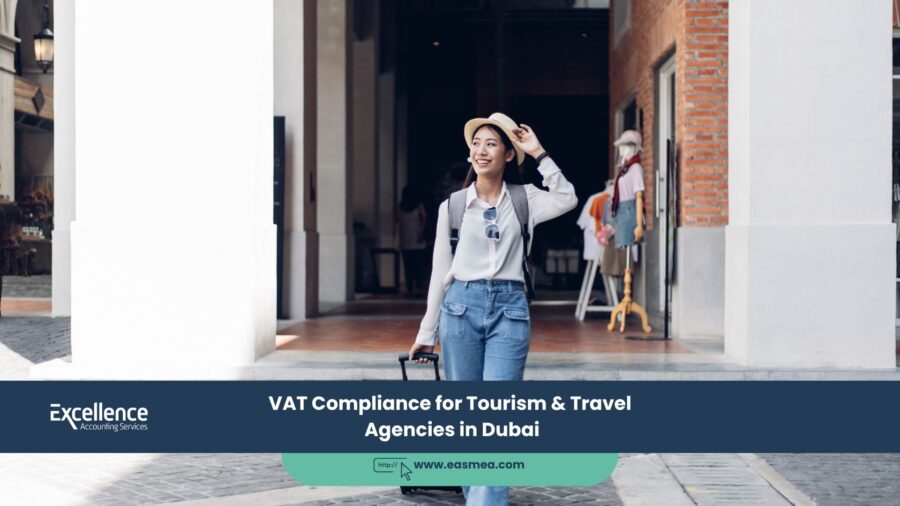VAT Compliance for Tourism & Travel Agencies in Dubai
Dubai’s position as a global hub for tourism and travel is undeniable. The city’s dynamic landscape of world-class attractions, luxury hotels, and seamless connectivity makes it a prime destination for millions of visitors annually. For the thousands of travel agencies, tour operators, and destination management companies (DMCs) that form the backbone of this vibrant industry, navigating the financial and regulatory environment is as crucial as crafting the perfect itinerary. Chief among these regulations is Value Added Tax (VAT).
- VAT Compliance for Tourism & Travel Agencies in Dubai
- Part 1: The Core Challenge - Place of Supply Rules
- Part 2: The Tour Operator Margin Scheme (TOMS) - A Deep Dive
- Part 3: Principal vs. Agent - A Critical Distinction
- Part 4: VAT Treatment of Specific Travel Services
- Specialized VAT Support for the Travel Industry from EAS
- Frequently Asked Questions (FAQs)
- Is Your Agency's VAT Approach First-Class?
The travel and tourism sector is one of the most complex industries from a VAT perspective. Unlike a simple retail transaction, travel services involve intricate supply chains, cross-border elements, and special schemes that can bewilder even seasoned professionals. Understanding concepts like the place of supply, disbursements, and the highly specialized Tour Operator Margin Scheme (TOMS) is not just advisable—it is essential for survival and growth. Misinterpreting these rules can lead to incorrect VAT calculations, FTA penalties, and eroded profit margins. This comprehensive guide will serve as your compass, navigating the specific VAT rules that govern travel and tourism businesses in Dubai, ensuring you remain compliant while maximizing your financial efficiency.
Key VAT Takeaways for Travel Agencies
- Tour Operator Margin Scheme (TOMS): This is a mandatory, simplified accounting method for businesses that buy and sell travel components. VAT is calculated on the profit margin, not the full selling price.
- Place of Supply is Crucial: The VAT treatment of a service (whether it’s 5%, 0%, or out of scope) depends on where the service is enjoyed or consumed.
- Zero-Rated Supplies: International transportation (flights) and services consumed outside the GCC are generally zero-rated, offering a significant advantage.
- Input VAT under TOMS is Blocked: When using TOMS, you cannot recover the VAT paid on the travel components you buy (e.g., hotel rooms, tours). VAT on general overheads is still recoverable.
- Principal vs. Agent: Your VAT liability differs drastically depending on whether you act as a principal (reselling a package) or an agent (earning a commission).
Part 1: The Core Challenge – Place of Supply Rules
The first principle to master is the “place of supply.” This determines whether a service is subject to UAE VAT. For the travel industry, the rules are specific:
- Transport Services: The place of supply for transporting passengers is where the transport begins. A flight from Dubai to London is a UAE supply, while a flight from London to Dubai is not.
- Hotel Accommodation & Restaurant Services: The place of supply is where the hotel or restaurant is physically located.
- Tours & Excursions: The place of supply for services related to real estate (like a tour of the Burj Khalifa) is where the real estate is located.
- Other Services (Agency Fees, etc.): The default rule applies—the place of supply is the supplier’s place of residence (the UAE).
This means a travel package sold from Dubai can contain a mix of services with different VAT treatments. For example, a package including a flight from Dubai, a hotel in Paris, and a tour in Rome is a complex mix of UAE and non-UAE supplies.
Part 2: The Tour Operator Margin Scheme (TOMS) – A Deep Dive
To simplify the complexities of place of supply, the FTA implemented the Tour Operator Margin Scheme (TOMS). This is not an optional scheme; it is a mandatory way of accounting for VAT for any business that buys and resells certain travel services as a principal.
Who Must Use TOMS?
You must use TOMS if you are a VAT-registered business in the UAE and you buy and sell “designated services” in your own name (i.e., as a principal). A designated service includes:
- Hotel accommodation
- Passenger transport (flights, buses, cruises)
- Tours, excursions, and trips
- Ancillary services like travel insurance
If you simply arrange a hotel booking for a client and receive a commission from the hotel, you are acting as an agent, and TOMS does not apply. If you buy a hotel room for AED 800 and sell it to a client for AED 1,000, you are acting as a principal, and TOMS applies. This distinction is critical and requires robust internal audit and control processes to classify correctly.
How TOMS Works: The Margin Calculation
Under TOMS, you do not charge VAT on the full selling price of the travel package. Instead, you calculate VAT on your profit margin.
Margin = Selling Price (excluding VAT) – Cost of Designated Services (including any VAT you paid)
The VAT due is then calculated on this margin. If the components of the package are consumed within the UAE, the margin is subject to 5% VAT. If the components are consumed outside the GCC (e.g., a European holiday package), the margin is zero-rated (0% VAT).
Example Calculation:
| Component | Details |
|---|---|
| Package Sold: | 2-night staycation in a Dubai hotel with a desert safari tour. |
| Selling Price to Customer: | AED 2,500 |
| Your Cost for Hotel (incl. 5% VAT): | AED 1,890 |
| Your Cost for Safari Tour (incl. 5% VAT): | AED 420 |
| Total Cost of Designated Services: | AED 1,890 + AED 420 = AED 2,310 |
| Margin: | AED 2,500 – AED 2,310 = AED 190 |
| VAT Due to FTA (on the margin): | AED 190 is considered inclusive of VAT. So, VAT = 190 * (5/105) = AED 9.05 |
The Major Drawback of TOMS: Blocked Input Tax
A crucial feature of TOMS is that you cannot recover the input VAT you pay on the designated services you buy. In the example above, you cannot claim the VAT included in the AED 1,890 hotel cost or the AED 420 safari cost. This is a fundamental trade-off for the simplification the scheme provides.
However, you can still recover VAT on your general business overheads (e.g., office rent, marketing, GDS subscription fees, HR consultancy fees) subject to the normal recovery rules.
Part 3: Principal vs. Agent – A Critical Distinction
Your business model determines your VAT liability. It is vital to understand which role you are playing in any given transaction.
Acting as a Principal (or “Undisclosed Agent”)
- You contract with suppliers in your own name.
- You issue an invoice to the customer in your own name.
- You bear the commercial risk (e.g., unsold hotel rooms).
- VAT Treatment: TOMS applies. You account for VAT on your margin.
Acting as an Agent (or “Disclosed Agent”)
- You arrange for a service to be provided by a third party to the customer.
- The invoice for the main service (e.g., the flight) is often between the supplier and the customer.
- Your income is a commission or service fee, which you invoice separately.
- VAT Treatment: TOMS does not apply. You charge 5% VAT on the value of your commission/service fee.
Properly distinguishing these roles is a core part of your accounting and bookkeeping setup.
Part 4: VAT Treatment of Specific Travel Services
1. Flights
The supply of international passenger transport is zero-rated. This includes flights from the UAE to another country or flights that transit through the UAE as part of a single journey. Domestic flights within the UAE are subject to 5% VAT.
2. Visa Services
The fee for arranging a UAE visa is standard-rated at 5%. Government fees paid as part of the visa application are often treated as disbursements and are outside the scope of VAT, provided specific conditions are met.
3. Travel Insurance
The supply of travel insurance is generally exempt from VAT, but any administrative fee you charge for arranging it is standard-rated at 5%.
4. Invoicing and Record-Keeping
Maintaining accurate records is non-negotiable. For TOMS, your tax invoice must not show a separate VAT amount. The total price is shown as a single figure. You must also maintain records to clearly show how you calculated your margin for each tax period.
Using a modern accounting system like Zoho Books is vital. It can be configured to handle the unique requirements of TOMS and separate agency commission calculations, ensuring your VAT return filing is accurate and backed by a solid audit trail.
Specialized VAT Support for the Travel Industry from EAS
The unique challenges of VAT in the tourism sector require specialist knowledge. Excellence Accounting Services provides expert, industry-specific support to ensure your agency is compliant and efficient.
- TOMS Implementation and Review: We help you correctly implement and manage the Tour Operator Margin Scheme, ensuring your margin calculations are accurate and defensible.
- Principal vs. Agent Advisory: Our business consultancy services help you structure your contracts and invoicing to clearly define your role and optimize your VAT position.
- VAT Return Filing: We manage the complexities of your VAT return, correctly reporting TOMS supplies, zero-rated exports, and agency fees.
- FTA Audit Support: With our deep expertise in travel VAT and external audit experience, we can expertly represent you during any FTA inquiries.
- Comprehensive Financial Management: Beyond VAT, our CFO services provide strategic oversight for your agency’s financial health, from managing accounts receivable from customers to handling accounts payable to hotels and airlines.
Frequently Asked Questions (FAQs)
No, you cannot opt out. If you are a VAT-registered business buying and reselling designated services as a principal, the use of TOMS is mandatory for those supplies.
If your costs for the designated services are higher than your selling price, the margin is negative. In this case, the margin is treated as zero, and no output VAT is due. You cannot use a loss from one trip to offset a profit on another.
Under TOMS rules, you must issue an invoice that does not show a separate VAT amount. This means your business customer cannot recover any VAT on the trip, as there is no input tax for them to claim. This is a key commercial aspect of the scheme to be aware of.
This is a package where the services are consumed outside the GCC. Under TOMS, the margin you make on this package would be zero-rated. You would still calculate your margin, but you would apply 0% VAT to it. This must be reported on your VAT return.
No. If your only income is a commission for acting as an agent, TOMS does not apply. Your responsibility is to charge 5% VAT on your commission fee when you invoice the airline or the customer for your service.
Yes. The input tax block under TOMS only applies to the direct costs of the designated services (the travel components). You can still recover VAT on your general business overheads, subject to the normal rules. If all your sales are TOMS supplies, you will need to perform an apportionment calculation.
A disbursement is a cost you pay on behalf of your customer (e.g., a government visa fee). To qualify, you must not have any markup on the fee and the customer must be the true recipient of the supply. True disbursements are outside the scope of VAT and do not form part of your turnover or TOMS calculation.
If you issue a credit note to the customer and refund them, this will reduce your selling price for the TOMS calculation. This would, in turn, reduce your margin and the output tax due on it. The specific treatment depends on your cancellation policy and whether you retain any portion of the payment.
The legislation allows for the calculation to be done on an aggregate basis for each tax period. You would calculate the total selling price of all TOMS supplies and the total cost of all TOMS supplies in a period to determine the total margin, which simplifies the process significantly compared to a trip-by-trip calculation.
The most common and costly mistake is incorrectly identifying whether they are acting as a principal or an agent. Applying the wrong VAT treatment (e.g., charging 5% on a full package price instead of using TOMS, or vice versa) can lead to significant under or overpayment of tax and attract severe penalties from the FTA.
Conclusion: Charting a Course for Compliance
VAT compliance in the travel and tourism sector is undoubtedly complex, but it is not insurmountable. By building a deep understanding of the core principles—especially the mandatory Tour Operator Margin Scheme—and establishing robust internal processes, travel agencies in Dubai can confidently navigate their obligations. A clear distinction between principal and agent activities, meticulous record-keeping, and leveraging the right accounting technology are the hallmarks of a well-run, compliant operation. Investing in professional advice is not a cost but a strategic decision that protects your business from risk and allows you to focus on creating unforgettable travel experiences for your clients.




